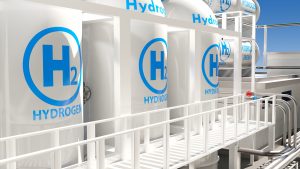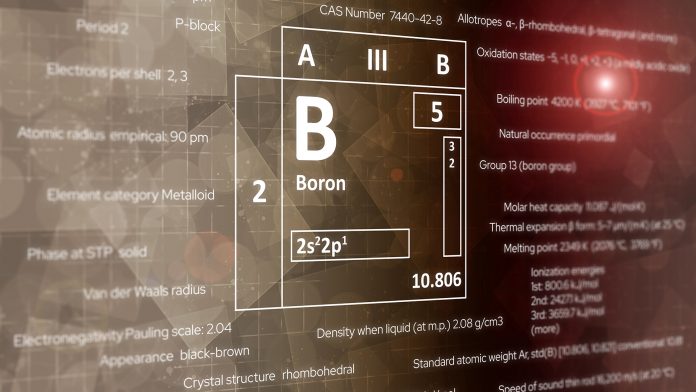Boron’s unique properties hold untapped potential for renewable energy technologies, prompting a deeper exploration into this fascinating element.
In the search for viable solutions to our planet’s escalating energy crisis, the scientific community is increasingly drawn to the exploration of lesser-known elements and their potential applications.
Among these, boron, a nonmetallic element straddling the line between metals and nonmetals on the Periodic Table, presents itself as a noteworthy contender.
Its unique properties, such as electron-deficiency and an unoccupied p orbital, make boron an intriguing subject in the realm of energy conversion and storage.
From synthesising energy-rich small molecules to its burgeoning role in light-emitting diodes and photovoltaic applications, boron’s multifaceted implications for renewable energy technologies beckon further examination.
Understanding boron’s role in energy
To comprehend the significant role of boron in energy-related applications, it is crucial to delve into its unique properties and diverse functions in energy conversion, storage, and activation of small molecules.
Boron, located at the crossroads of metals and nonmetals in the Periodic Table, is a powerhouse of potential for energy-related research due to its electron-deficiency and unoccupied p orbital. These characteristics facilitate the formation of a plethora of compounds with diverse properties.
Boron’s role in energy conversion and storage is particularly noteworthy. It is involved in the synthesis of energy-rich small molecules and the storage of chemical and electrical energy.
Additionally, boron is capable of converting electrical energy into light, making it a valuable element in energy technologies.
Boron-based systems, such as frustrated Lewis pairs, diboranes, and diborenes, have shown promising results in the activation of small molecules.
Moreover, boron compounds are being used in hydrogen storage due to their high hydrogen capacity by weight. The versatility and potential of boron underpin its significance in energy-related applications, highlighting the element’s promise for future energy solutions.
Activating small molecules with boron
Building on boron’s multifaceted role in energy, we now turn our focus to its ability to activate small molecules. Boron’s unique properties, such as electron-deficiency and unoccupied p orbital, allow it to form compounds with diverse properties, making it a key player in energy-related research.
Frustrated Lewis pairs, along with diboranes, diborenes, and borylenes, promote the activation of small molecules such as dihydrogen, dinitrogen, and carbon dioxide.
Furthermore, borylene species have shown potential for metal-free small-molecule activation.
While the ability of boron to activate small molecules has been established, further research is needed to uncover the full extent of boron’s potential in this area.
As we continue to explore the untapped potential of boron, it is clear that its ability to activate small molecules could play a significant role in advancing renewable energy technologies.
Boron compounds for hydrogen storage
In the realm of energy storage, boron compounds, particularly boranes and borohydrides, showcase immense potential as hydrogen carriers due to their high hydrogen capacity by weight. These compounds offer advantageous volumetric and gravimetric densities of hydrogen, making them viable contenders for energy storage applications.

Amine boranes, for instance, possess a high hydrogen capacity with a relatively low hydrogen release temperature.
Light-metal borohydrides, on the other hand, require high temperatures for dehydrogenation and face issues with the formation of stable borides and elemental boron.
Less studied but equally promising are octahydrotriborates. Although they have reduced reactivity of hydridic hydrogen atoms, their potential for hydrogen storage cannot be overlooked.
Lastly, BCN heterocyclic compounds present a promising avenue for hydrogen storage and energy-related applications.
The high hydrogen capacity of these boron compounds makes them an area of keen interest in the renewable energy sector. Further research and development may pave the way for their wider use in efficient and sustainable energy storage solutions.
Advances in Frustrated Lewis Pair catalysis
Frustrated Lewis Pair (FLP) catalysis, a rapidly evolving field in chemistry, has seen significant advancements with far-reaching implications for energy-related applications. These advancements have centred around the ability of FLPs to perform reactions typically reserved for transition metals.
Boron’s unique characteristics have been harnessed in these reactions, with boron-based FLPs exhibiting a particular ability to activate small molecules.
Recent advancements have seen FLP catalysis achieve water-tolerance, a significant milestone. This has expanded the scope of FLP catalysis, allowing for its application in more varied and challenging environments.
Additionally, highly enantioselective conversions have been developed. This opens up the potential for the use of FLP catalysis in the synthesis of chiral molecules, a crucial aspect of pharmaceutical and agrochemical manufacturing.
Another noteworthy achievement is the successful intermolecular C(sp)−H bond activation and borylation of heteroarenes using FLPs. This is a testament to the versatility and potential of FLP catalysis in the realm of energy technology.
As research continues, the role of boron in FLP catalysis is expected to expand, driving further advancements in this exciting field.
Boron in light-emitting diodes
Harnessing the unique properties of boron has led to significant advancements in the development and efficiency of light-emitting diodes (LEDs). Boron’s electron-deficient nature and the ability to form energy-rich compounds have made it an essential ingredient in the creation of high-performance LEDs.
Boron-doped LEDs exhibit enhanced performance characteristics such as improved brightness, colour purity, and energy efficiency. The boron atoms replace some of the semiconductor atoms in the LED structure, introducing additional energy levels that allow for the recombination of electrons and holes, leading to the emission of light.
Whilst boron-doping has shown promising results in LED technology, further research is required to fully understand and optimise its role.
The potential of boron in renewable energy technologies, including its use in LEDs, offers promising opportunities for the development of more efficient and sustainable lighting solutions.
Photovoltaic applications of boron
Exploiting the unique properties of boron has recently opened up new avenues in the development of photovoltaic technologies. Its ability to form stable complexes with various elements and its high affinity for electrons make it an ideal dopant in photovoltaic cells, particularly in silicon-based solar cells.

Boron’s role in photovoltaic applications primarily involves the creation of p-type semiconductors. These are materials that accept electrons, creating what are known as ‘holes.’
These holes, in essence, act as positive charge carriers and are fundamental in the operation of photovoltaic cells. When sunlight strikes the solar cell, electrons are knocked loose and move towards the n-type material, leaving behind these holes in the p-type material. This movement of electrons creates an electric current which can be harnessed for power.
Moreover, boron’s ability to form complexes with carbon (boron-carbon compounds) provides further potential for photovoltaic applications. Research into boron-carbon compounds suggests they could serve as effective light-harvesting materials in organic solar cells.
Ultimately, the unique properties of boron present promising opportunities for the development of more efficient, cost-effective renewable energy technologies.
Boron-based batteries
Building on the promising role of boron in photovoltaic applications, its unique properties also lend themselves to the development and optimisation of boron-based batteries.
Boron’s electron-deficiency and unoccupied p orbital enable the formation of diverse compounds, making it an ideal candidate for energy storage solutions.
The potential of boron-based batteries lies in their high energy density and thermal stability. They are particularly promising for electric vehicles and portable electronic devices, where weight and size are crucial parameters.
Boron’s unique ability to form stable, complex structures can be harnessed to create batteries with high charge retention and longer life cycles.
Boron hydride complexes, due to their high hydrogen storage capacity, are being explored for their use in hydrogen fuel cells. These boron-based fuel cells can potentially offer high energy conversion efficiency and low environmental impact, making them a sustainable alternative to traditional energy sources.
The unique properties of boron open up exciting possibilities in the realm of renewable energy storage.









